Shimane Museum of Ancient Izumo will be closed from April 2025 to September 2026 (tentative) due to seismic retrofitting and other renovation works.
Izumo Grand Shrine and the rituals
A glimpse at (the ancient people of) Shimane’s soul centering on the mystery of the Izumo Grand Shrine is introduced from various angles.
(1)Izumo Grand Shrine: Founding
(2)Izumo Grand Shrine: Changes to the Main Sanctuary
(3)Kamiarizuki: The “Month with Gods”
(4)Offerings to the deities
(1)Izumo Grand Shrine: Founding
The “Izumo Grand Shrine and Its Rituals” gallery is a themed exhibition about the history, architecture, and rituals of Izumo Grand Shrine—a major Shinto shrine located next to the museum. The main deity worshipped at the shrine is Ōkuninushi no Kami (“Great Lord of the Land”), a god of agriculture, nation building, and en-musubi (“tying of bonds between people”). The concept of en-musubi comprises not only the relationships between couples, neighbors, and coworkers, but also the success of farmer’s harvests and other positive outcomes in people’s daily lives.
The exact founding of Izumo Grand Shrine is uncertain, but the shrine’s origin is depicted in the kuni-yuzuri (“relinquishing the land”) myth, which appears in the Kojiki (Record of Ancient Matters) and Nihon shoki (Chronicle of Japan). Another myth describing the shrine’s founding is recorded in the Izumo no kuni fudoki (Gazetteer of Izumo Province). All three of these texts date from the eighth century and testify to the long-standing significance of the shrine.
Izumo Grand Shrine has been rebuilt many times throughout its history. The main sanctuary (honden) has generally followed the taisha-zukuri style, a type of shrine architecture based on ancient dwellings. Taisha-zukuri structures have a gable roof with stairs leading to an off-center entrance on the building’s gable end (one of the building’s shorter sides); this entrance is called a tsumairi. Taisha-zukuri structures also have a high floor raised on pillars. In the museum gallery, a rare early artifact—an earthenware pot dating to the first century CE—depicts this kind of elevated structure. Excavated in neighboring Tottori Prefecture, the pot is engraved with a building set on pillars and accessed by a long stairway.
Several other artifacts in the exhibit indicate that Izumo held special significance as early as the Yayoi period (800 BCE–300 CE). For example, a comma-shaped bead (magatama) and bronze dagger-axe (dōka) dating to the Yayoi period were excavated near the shrine. The bead was produced in what is now Niigata Prefecture, in northwest Japan, and the dagger-axe was produced in northern Kyushu, a main island to the west. The tremendous distance each of these artifacts traveled indicates the importance of Izumo in ancient times. Even stronger evidence is provided by the ritual burials of Yayoi-period bronze bells and swords that were found at sites nearby.
Ancient versions of the main sanctuary are said to have been truly grand structures, towering over the landscape at 48 meters in height. Kuchizusami, a tenth-century educational text for aristocratic children, describes Izumo Grand Shrine as the tallest building in the country at the time, alongside the Daibutsuden (Great Buddha Hall) at Tōdaiji Temple in Nara, and the administrative building of the imperial court in Kyoto. The large 1/10-scale model at the center of the gallery represents one interpretation of how Izumo Grand Shrine may have looked during the tenth century.
(This English-language text was created by the Japanese Tourism Agency.)
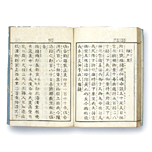
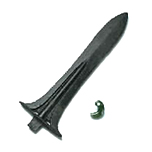
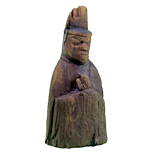
(2)Izumo Grand Shrine: Changes to the Main Sanctuary
Izumo Grand Shrine has been rebuilt many times since its founding. The tradition of sengū (“periodic rebuilding of the shrine”) has played a role in the changing appearance of the shrine precinct and structures—particularly that of the main sanctuary (honden). The “Izumo Grand Shrine and Its Rituals” gallery displays numerous versions of the main sanctuary as it is thought to have looked at various points in history.
Earlier versions of the sanctuary were said to be massive in scale, but until the archaeological discoveries in 2000, very little physical evidence existed. One exception was Kanawa no gozōei sashi zu (Diagram for the Placement of Metal Rings during Shrine Construction), a replica of which is on display in the exhibit. Dating to sometime between the thirteenth and sixteenth centuries, the diagram depicts the main sanctuary as a structure supported by nine pillars arranged in a three-by-three pattern. Each pillar is three meters in diameter and consists of a trio of logs bound together by metal bands. While the height of the building is not given, the entrance staircase is noted as roughly 109 meters long, indicating a structure of considerable size. In 2000, the discovery of the remains of several pillars near the current main sanctuary gave further credibility to the idea that a such a large structure once existed. The size and arrangement of the pillars are similar to the depiction in the Kanawa no gozōei sashi zu diagram, and radiocarbon dating indicates that the logs were likely installed in 1248.
Despite this new evidence, the exact appearance of the thirteenth-century sanctuary remains hard to determine. This is evident in the five different 1/50-scale models displayed in the exhibit; each one represents a different architect’s interpretation of how the sanctuary might have looked.
The models show the main sanctuary painted red—a reflection of the influence of Buddhist architectural practices. Between the thirteenth and seventeenth centuries, Izumo Grand Shrine was closely affiliated with a nearby Tendai Buddhist temple. The museum gallery contains a diorama of the shrine precincts in 1609: the main sanctuary and other shrine buildings painted red, and a three-story pagoda (a traditionally Buddhist structure) standing on the shrine grounds.
During a major rebuilding of the shrine in 1667, a conscious effort was made to reduce Buddhist influence in the shrine’s architecture. The new main sanctuary and surrounding structures were left unpainted, and the shrine’s bell tower (another feature common to Buddhist temples) was demolished. The bell from the tower and the shrine’s grand three-story pagoda were donated to other religious institutions. These substantial changes in the shrine’s appearance are evident in another diorama, this one portraying the shrine as it looked in 1667. The current main sanctuary, constructed in 1744, looks very similar to the one from 1667.
While in past centuries the main sanctuary was periodically rebuilt, there has been no new construction since 1744—particularly once the current structure was designated a National Treasure in 1952. Instead, extensive maintenance is performed roughly every 60 years. This occurred most recently in 2013, when the sanctuary’s cypress-bark roof was replaced. On the rear wall of the gallery, visitors can view an immense forked finial and billet that adorned the roof from 1881 until 1953.
(This English-language text was created by the Japanese Tourism Agency.)
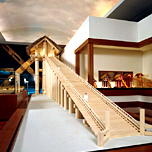
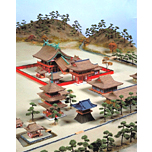
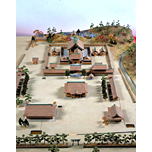
(3)Kamiarizuki: The “Month with Gods”
During the tenth month of the lunar calendar, the myriad deities from across Japan are said to gather in Izumo. Over the course of a week, they consult with Izumo Grand Shrine’s main deity, Ōkuninushi no Kami, to determine things like the success or failure of harvests and the relationships that people will form in the next year. Thus, while this period is referred to as the “month without gods” (kannazuki) in most of the country, it is called the “month with gods” (kamiarizuki) in Izumo.
The origin of the annual gathering in Izumo is tied to stories recorded in Japan’s earliest written records, which date to the early eighth century but are thought to record even older oral histories. The kuni-yuzuri (“relinquishing the land”) myth describes how Ōkuninushi agreed to cede control of the land to the descendants of the sun goddess Amaterasu Ōmikami in exchange for a magnificent shrine and the authority to govern the “unseen world.” This unseen world referred not only to the realm of deities, but also included matters dealing with human spirits. In this way, Ōkuninushi became a god of en-musubi (“tying of bonds between people”), and Izumo Grand Shrine was established as his main place of worship.
During kamiarizuki, the visiting deities are housed in subsidiary shrines to the east and west of the main sanctuary. They meet each day at a small shrine complex near Inasa Beach, roughly a kilometer west of Izumo Grand Shrine, and determine the fate of human relationships in the upcoming year. In the “Izumo Grand Shrine and Its Rituals” gallery (left of the central lobby), there is a woodblock ukiyo-e print on display that shows an artist’s vision of this lively gathering. Produced in the nineteenth century, the print shows Ōkuninushi seated in the center of a crowded room. Various deities can be seen writing the names of individuals on wooden tablets and tying these together with string. The resulting pairings are then shown to Ōkuninushi for approval, and he confirms the fate of each couple.
(This English-language text was created by the Japanese Tourism Agency.)
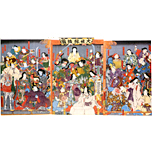
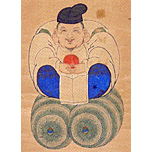
(4)Offerings to the deities
Observe some aspects of people’s faith through the craftwork and the paintings dedicated to the shrines and temples in Shimane Prefecture including the Izumo Grand Shrine.
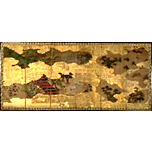
|
Shimane Museum of Ancient Izumo 99-4 kizuki-Higashi, Taisha, Izumo City, Shimane Prefecture, 699-0701 JAPAN TEL +81-853-53-8600/FAX +81-853-53-5350 | Copyright © 2007 Shimane Museum of Ancient Izumo. All rights reserved. |
